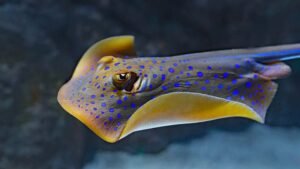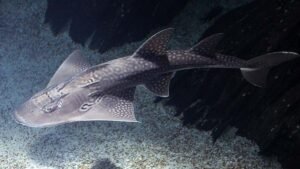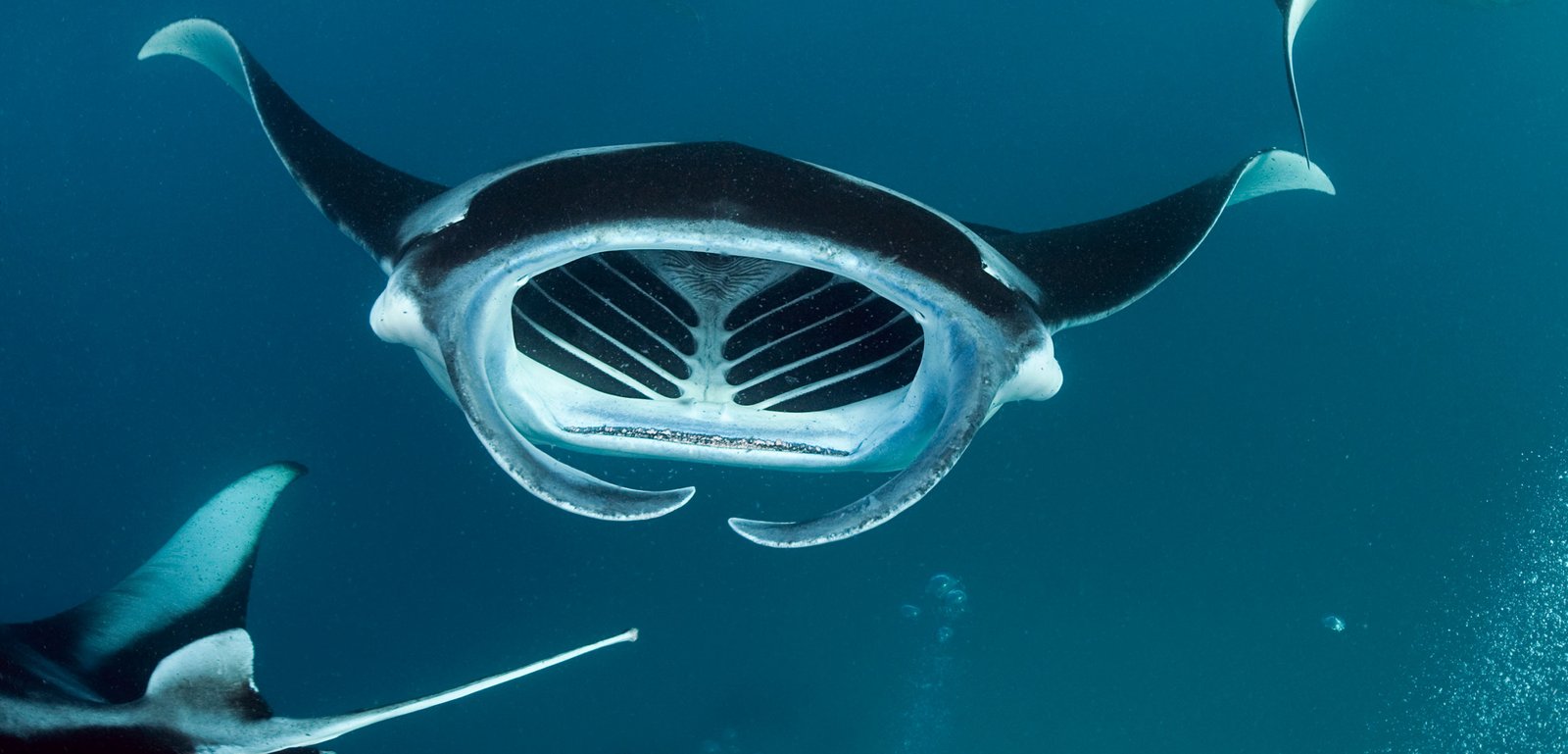The Fascinating World of Rays
One of the most well-known types of rays is the manta ray. These majestic creatures have a wingspan that can reach up to 25 feet, making them one of the largest species of rays in the world. Manta rays are known for their graceful movements and their ability to glide effortlessly through the water. They can be found in warm tropical waters, often near coral reefs where they feed on plankton and small fish.
Another type of ray that is commonly found in the oceans is the stingray. Stingrays are known for their unique body shape, with their flattened bodies and long, whip-like tails. They have a venomous stinger at the base of their tail, which they use for self-defense. Stingrays can be found in a variety of habitats, including sandy bottoms, rocky reefs, and seagrass beds. They are opportunistic feeders, using their powerful jaws to crush and eat a wide range of prey, including crustaceans, mollusks, and small fish.
Rays are also known for their interesting migration patterns. Many species of rays undertake long-distance migrations in search of food or to reproduce. For example, the spotted eagle ray is known to travel long distances across the ocean, often in large groups. These migrations can span hundreds or even thousands of miles and are crucial for the survival and reproduction of these magnificent creatures.
When it comes to breeding, rays have a unique reproductive system. Most species of rays are ovoviviparous, which means that the females give birth to live young. However, instead of giving birth to fully developed pups, rays give birth to small, miniature versions of themselves called pups. These pups are then left to fend for themselves and grow into adults.
Rays can be found in a wide range of habitats, from shallow coastal waters to deep-sea trenches. Some species prefer warm tropical waters, while others can tolerate colder temperatures. They are often found in areas with abundant food sources, such as coral reefs, estuaries, and kelp forests. Rays play a vital role in their ecosystems, helping to maintain the balance of marine populations by feeding on smaller prey species.
In conclusion, rays are truly fascinating creatures that inhabit the world’s oceans. Their diverse shapes and sizes, migration patterns, feeding habits, and unique reproductive system make them a captivating subject of study. By understanding more about these incredible creatures, we can work towards their conservation and ensure their continued presence in our oceans for future generations to admire and appreciate.
Types of Rays
There are more than 600 known species of rays, each with its own unique characteristics. Some of the most well-known types include:
Manta Rays
Manta rays are the largest species of rays, with wingspans that can reach up to 29 feet (8.8 meters). These gentle giants are known for their graceful movements and filter-feeding habits. They can be found in tropical and subtropical waters around the world.
Stingrays
Stingrays are perhaps the most recognizable type of ray, thanks to their distinctive flat bodies and long, whip-like tails. They are equipped with venomous spines on their tails, which they use for self-defense. Stingrays can be found in both freshwater and saltwater environments.
Electric Rays
Electric rays, also known as numbfishes, have the unique ability to produce electric shocks. They use these shocks to stun their prey and to defend themselves against predators. Electric rays are typically found in shallow coastal waters.
Skates
Skates are closely related to rays and are often mistaken for them. However, skates have a more triangular shape and lack the venomous spines found in stingrays. They can be found in a wide range of habitats, from shallow coastal waters to deep-sea environments.
In addition to these well-known types, there are many other fascinating species of rays. For example, the sawfish is a type of ray that has a long, saw-like snout lined with sharp teeth. This unique adaptation allows sawfish to easily catch and eat their prey. Sawfish can be found in both freshwater and saltwater habitats, and they are known for their powerful swimming abilities.
Another interesting type of ray is the guitarfish. As the name suggests, guitarfish have a body shape that resembles a guitar, with a long, flat snout and a broad, triangular body. They are bottom-dwelling creatures and are well-adapted to life on the ocean floor. Guitarfish can be found in warm coastal waters around the world, and they are known for their ability to camouflage themselves in sandy or muddy environments.
One more notable type of ray is the eagle ray. These rays have a distinctive diamond-shaped body and long, slender tails. They are known for their acrobatic swimming style, often leaping out of the water and performing flips in the air. Eagle rays can be found in both tropical and temperate waters, and they are commonly seen in shallow coastal areas.
These are just a few examples of the diverse and fascinating types of rays that inhabit our oceans and waterways. Each species has its own unique adaptations and behaviors, making them a truly remarkable group of marine creatures.
Migration Routes
Rays are known to undertake long-distance migrations in search of food, mating opportunities, and suitable habitats. The migration patterns of rays can vary depending on the species and their specific needs.
For example, some species of manta rays are known to migrate long distances between feeding and breeding grounds. They may travel hundreds or even thousands of miles in search of plankton-rich waters and suitable mates.
Other species, such as stingrays, may have more localized migration patterns. They may move between different habitats within a specific area, following seasonal changes in food availability or water temperature.
One fascinating example of ray migration is the annual journey of the cownose rays in the Chesapeake Bay. Each spring, thousands of cownose rays migrate northward from their overwintering grounds in the warmer waters of the southern Atlantic Ocean. They travel in large schools, creating a spectacular sight as they glide through the shallow waters of the bay.
During their migration, the cownose rays follow a specific route, navigating by using a combination of environmental cues and their own innate sense of direction. They are believed to rely on the Earth’s magnetic field, as well as landmarks and ocean currents, to guide them on their journey.
The purpose of this migration is twofold: to find abundant food sources and to give birth to their young. The Chesapeake Bay provides an ideal environment for both activities. The rays feast on the bay’s rich population of clams, oysters, and small fish, while the shallow, protected waters serve as a nursery for their pups.
Once the summer comes to an end, the cownose rays begin their southward migration back to the warmer waters of the Atlantic Ocean. This cyclical migration ensures the survival and continuation of the species, as it allows the rays to take advantage of the seasonal abundance of resources in different areas.
While the migration routes of rays can be impressive in terms of distance covered, they are also vulnerable to various threats along the way. Human activities such as overfishing, habitat destruction, and pollution can disrupt their migration patterns and negatively impact their populations.
Understanding the migration routes of rays is crucial for their conservation. By identifying and protecting key habitats along their migratory paths, we can help ensure the survival of these magnificent creatures and the ecosystems they depend on.
Feeding Habits
Rays have a diverse range of feeding habits, depending on their species and available food sources. Some rays are filter feeders, while others are active predators.
Manta rays, for example, are filter feeders that primarily consume plankton. They have large, open mouths that they use to scoop up tiny organisms from the water. The plankton is then filtered out through specialized gill rakers, allowing the rays to extract nutrients.
On the other hand, stingrays are bottom-dwelling predators that feed on a variety of small fish, crustaceans, and mollusks. They use their flat bodies and powerful jaws to crush their prey before consuming it.
Electric rays have a unique feeding strategy. They use their electric shocks to immobilize their prey, making it easier to capture and consume.
Another fascinating feeding behavior exhibited by some rays is the symbiotic relationship they have with other marine creatures. For instance, certain species of rays have been observed engaging in a mutually beneficial partnership with cleaner fish. These cleaner fish swim around the rays, picking off parasites and dead skin from their bodies. In return, the rays receive a thorough cleaning and potentially improved health. This symbiotic relationship not only benefits the rays but also provides a reliable food source for the cleaner fish, creating a harmonious balance in the ecosystem.
Additionally, some rays have developed specialized feeding techniques to adapt to their specific environments. Take the eagle ray, for example. This ray has a long, slender snout that it uses to probe the sandy ocean floor in search of buried prey. Once it detects a potential meal, the eagle ray uses its powerful pectoral fins to create a cloud of sand, effectively disorienting and exposing its prey. It then swiftly moves in to snatch up its unsuspecting victim.
Furthermore, certain species of rays have evolved to be highly skilled hunters. The mako ray, known for its impressive speed and agility, is a prime example. With its sleek body and sharp teeth, the mako ray is a formidable predator. It is capable of chasing down fast-swimming fish, such as tuna, and launching itself out of the water to catch its prey by surprise. This hunting technique, known as breaching, allows the mako ray to secure a meal that would otherwise be out of reach.
In conclusion, rays have a wide range of feeding habits, each uniquely adapted to their specific ecological niche. From filter feeding to predation, and even symbiotic relationships, these remarkable creatures have developed a variety of strategies to ensure their survival and success in the marine environment.
Breeding
Rays have a diverse range of reproductive strategies, depending on their species. Some rays reproduce through internal fertilization, while others rely on external fertilization.
In species that reproduce through internal fertilization, the males have specialized reproductive organs called claspers, which they use to transfer sperm to the females. The fertilized eggs are then either laid in egg cases or develop inside the female’s body before giving birth to live young.
In species that reproduce through external fertilization, the males release their sperm into the water, where the females swim through to fertilize their eggs. The fertilized eggs are then either laid in egg cases or develop inside the female’s body before hatching. 
Additionally, the breeding behavior of rays can also be influenced by environmental factors such as temperature and availability of food. Some species of rays have specific breeding seasons, during which they engage in courtship rituals to attract mates. These courtship rituals can involve elaborate displays of behavior, such as swimming patterns and color changes, to signal readiness for mating.
Furthermore, the size and age of rays can also play a role in their breeding patterns. In some species, larger and older individuals have a higher reproductive success rate, as they are more experienced and have developed better strategies for finding mates and protecting their offspring.
It is worth noting that the reproductive biology of rays is still not fully understood, and ongoing research is being conducted to uncover more about their breeding habits and strategies. Scientists are studying the genetic makeup of different ray species, as well as their reproductive organs and behaviors, to gain a better understanding of their reproductive biology.
Overall, the breeding habits of rays are incredibly diverse and fascinating, with different species employing various reproductive strategies to ensure the survival of their offspring in their respective environments.
Habitats
Rays can be found in a wide range of habitats, from shallow coastal waters to deep-sea environments. The specific habitat preferences of rays can vary depending on their species and ecological requirements.
Some rays, such as manta rays and stingrays, prefer warm tropical waters. They can often be found near coral reefs, where they feed on the abundant plankton and small fish that inhabit these ecosystems. Manta rays, known for their graceful movements and impressive size, are particularly fond of coral reef habitats. These gentle giants can reach wingspans of up to 23 feet and are often seen gliding effortlessly through the crystal-clear waters of the tropics. Stingrays, on the other hand, have a more secretive nature and tend to bury themselves in the sandy ocean floor, waiting patiently for prey to pass by.
Other species, such as skates and electric rays, are more adaptable and can be found in a variety of habitats. Skates, which are closely related to rays, are commonly found in temperate and cold waters. They are well-suited to rocky reefs and kelp forests, where they can camouflage themselves among the algae-covered surfaces. Electric rays, as their name suggests, possess the ability to generate electric shocks. These fascinating creatures inhabit both shallow and deep waters, often preferring sandy or muddy bottoms. They have been known to bury themselves in the sediment, using their electric organs to stun prey before devouring it.
In addition to these habitats, rays can also be found in seagrass beds, where they take advantage of the abundant food sources and shelter provided by the dense vegetation. These underwater meadows are teeming with life, making them ideal feeding grounds for rays. Some species, such as the eagle ray, are particularly skilled at maneuvering through the seagrass, using their long tails to navigate the maze-like environment.
Furthermore, certain species of rays have adapted to withstand the extreme conditions of the deep sea. These deep-sea rays are often found in the abyssal plains and trenches, where they have evolved unique characteristics to survive in the pitch-black depths. These extraordinary creatures possess bioluminescent features that help them navigate and communicate in the darkness, as well as specialized feeding mechanisms to capture prey in the nutrient-poor environment.
